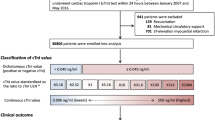Abstract
To examine the clinical course of patients with acute myocardial infarction complicated by “extension”, we studied prospectively 141 patients who had been diagnosed as having acute myocardial infarction. The serum CKMB level of these patients was determined at 8-h intervals during the first 5 days following admission. The patients were classified into 3 groups. (1) Group A (early extension): patients who showed CKMB re-elevation before the CKMB values reached normal levels (28%). (2) Group B (late extension): patients who showed CKMB re-elevation after the normalization of serum CKMB levels (21%). (3) Group C (control group): patients without CKMB relevation (51%). Patients in group A showed the most unfavourable clincial course with a greater rate of haemodynamic deterioration compared with patients in the B or C groups, and a higher rate of recurrent ischemic pain. We found no significant differences in these parameters between the B and C groups. We were unable to find any risk factor associated with the development of extension. The pattern of the serum CKMB curve may allow a separation of two different subgroups of patients with acute myocardial infarct extension: patients with early extenstion, who show a high prevalence of haemodynamic deterioration, and patients with late extension, characterized by small infarcts and a benign clinical course.
Similar content being viewed by others
References
Baker JT, Bramlet DA, Lester RM, Harrison DG, Roe CR, Cobb FR (1982) Myocardial infarct extension. Incidence and relationship to survival. Circulation 65:918
Buda AJ, MacDonald IL, Dubbin JD, Orr SA, Strauss HD (1983) Myocardial infarct extension: prevalence, clinical significance, and problems in diagnosis. Am Heart J 105:744
Coll S, Castañer A, Sanz G, Roig E, Magriña J, Navarro-López F, Betriu A (1983) Prevalence and prognosis after a first nontransmural myocardial infarction. Am J Cardiol 51:1584
Fraker TD, Wagern GS, Rosati RA (1979) Extension of myocardial infarction. Incidence and prognosis. Circulation 60:1126
Fuster V, Frye RL, Danielson MA, Connolly DC (1975) Collateral circulation after acute myocardial infarction. Protective or detrimental? Circulation 52 [Suppl. II] 2–733
Hackel DB, Reimer KA, Ideker RE, Mikat EM, Hartwell TD, Parker CB, Braunwald EB, Buja M, Gold HK, Jaffe AS, Raabe DS, Rude RE, Sobel BE, Stone PH, Roberts R, MILIS Study Group (1984) Comparison of enzymatic and anatomic estimates of myocardial infarct size in man. Circulation 70:824
Hollander G, Ozick H, Greenhart A, Shani J, Lichstein E (1984) High mortality early reinfarction with nontransmural myocardial infarction. Am Heart J 108:1412
Hutchins GM, Bulkley BH (1978) Infarct expansion versus extension. Two different complications of acute myocardial infarction. Am J Cardiol 41:1127
Hutter AN, DeSanctis RW, Flynn T, Yeatman LA (1981) Nontransmural myocardial infarction. A comparison of hospital and late clinical course with that of matched patients with transmural anterior and transmural inferior myocardial infarction. Circulation 71:211
Maisel AS, Ahnve S, Gilpin E, Henning H, Goldberger AL, Collins D, Lewinter M, Ross J Jr (1985) Prognosis after extension of myocardial infarct. The role of Q wave or non Q wave infarction. Circulation 71:211
Marmor A, Sobel BE, Roberts R (1981) Factors presaging early recurrent myocardial infarction (“extension”). Am J Cardiol 48:603
Marmor A, Geltman EM, Schechman K, Sobel BE, Roberts R (1982) Recurrent myocardial infarction. Clinical predictors and prognostic implications. Circulation 66:415
Marmor A, Ludbrook PA, Sobel BE, Roberts R (1981) Vascular determinants of early recurrent myocardial infarction. Am J Cardiol 47:418
Mathey D, Bleifeld W, Buss H, Hanrath P (1975) Creatine Kinase release in acute myocardial infarction: correlation with clinical, electrocardiographic and pathological findings. Br Heart J 37:1161
Muller JE, Maroko PR, Braunwald E (1978) Precordial electrocardiographic mapping. A technique to assess the efficacy of interventions designed to limit infart size. Circulation 51:1
Reid PR, Taylor DR, Kelly DT, Weisfeldt ML, Humphries JO, Ross RS, Pitt B (1974) Myocardial infarct extension detected by precordial ST-segment mapping. N Engl J Med 290:123
Rothkopf M, Boerner J, Stone MJ, Smitherman TC, Buja LM, Parkey RW, Willerson JT (1979) Detection of myocardial infarct extension by CK-B radioimmunoassay. Circulation 59:268
Strauss HD, MacDonald IL, Orr SA, Berman ND, Buda AJ (1981) Myocardial infarct extension. Incidence and relationship to survival. Circulation 65:918
Author information
Authors and Affiliations
Rights and permissions
About this article
Cite this article
Castellanos, M.A.D., Pérez, J.L., Ortiz, M.T.L. et al. Myocardial infarct extension. Identification of subgroups by the pattern of the serum CKMB level. Intensive Care Med 13, 273–277 (1987). https://doi.org/10.1007/BF00265117
Received:
Accepted:
Issue Date:
DOI: https://doi.org/10.1007/BF00265117




